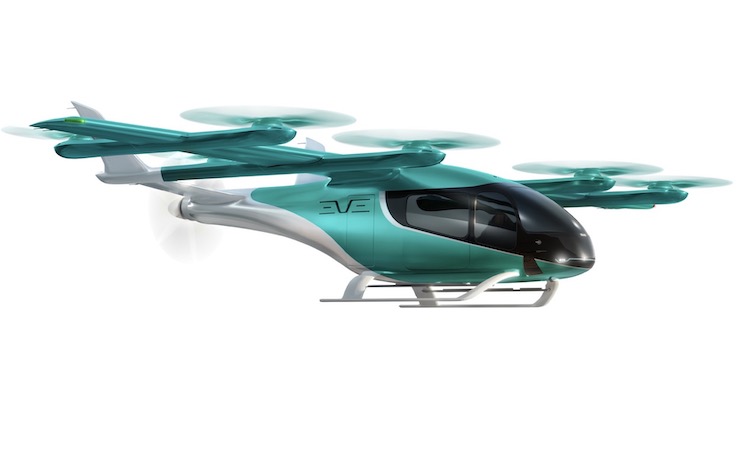
© EveAirMobility
The commercialization of drone passenger vehicles – once considered little more than a “Jetsonian” fantasy – is rapidly coming to fruition. Field tests of air taxi prototypes are underway all over the United States and investors are standing by to plunge millions – and perhaps billions – into eventual mass production. Meanwhile, partnership deals between the leading drone taxi start-ups and several of the nation’s largest and busiest airports have already been signed, in anticipation of FAA approval for a near-term operations launch.
Air taxis are coming – sooner rather than later – but probably not on the heady timetable that eager investors – and major cities, including Los Angeles, San Francisco,New York and Miami – are hoping and praying for.
Currently, the major American drone players include Archer Aviation, Joby, Eve an and Vertical Aero Integration, all of which are competing to become the first out of the gate – and into the skies. Eve, which is a subsidiary of the Brazilian aircraft powerhouse Embraer, has just inked a deal with United Airlines to provide the company with 400 of its high-performance eVTOL air taxis by 2026. The taxis will shepherd United’s passengers to the San Francisco International Airport from a downtown “vertiport” (whose location is still being determined) and then shepherd arriving passengers back. The operation could mark the first ever deployment of air taxis outside the confines of a test range.
But United has a similar plan to bring air taxis to the Los Angeles International Airport, and in this case, its partner is Archer Aviation, a Silicon Valley-based drone firm founded just two years ago. Michael Leskinen, United’s vice president of corporate development and investor relations, has expressed confidence in deploying Archer’s five-seat eVTOL aircraft – known as “Midnight” – by mid-decade.
“United Airlines has hubs in all the major business cities of the United States and congestion is a big issue,” Leskinen said during a public event two years ago. “This vehicle has the opportunity to make it easier to get to the airports and to do it quieter and safer . . . We partnered with Archer because we think they have the approach to get to market quickly with current technology.”
A third drone company, Joby, is partnering with Delta Airlines, while a fourth, Vertical Aero Integration, has a deal with American Airlines to provide its first 50 eVOTL air taxis by early next year. The various airline companies are attracting investor support and stakeholders in each city – from the Mayor to local business groups – are publicly and privately supporting the push, which they view as a major public relations and lucrative financial bonanza.
While major US airports are a natural first starting point for air taxi operations, all of the drone companies have far more ambitious long-term expansion plans. Archer hopes to expand to regional and local airports and eventually beyond airports to urban transportation networks currently serviced by road vehicles alone. In Los Angeles, the Mayor’s Office and several industry technology groups, including United Labs, are backing the initiative under the banner of “Urban Air Mobility,” a strategy designed to reduce traffic congestion, eliminate vehicle noise (especially from helicopters) and enhance sustainability.
The Federal Aviation Administration (FAA), which has expressed skepticism about other drone initiatives, especially in the area of remote package delivery, appears fully committed to air taxis. The FAA has expedited approval of company prototypes to facilitate their field testing and is prepared to issue formal airworthiness certificates to drone taxis that meet its safety and performance standards. But no company has commenced full-scale production of its aircraft.
In addition to technological issues, numerous legal and regulatory barriers must still be surmounted for air taxis to be flown commercially. Experts consulted by McKinsey, for example, have suggested that 2035 be a more realistic start-date for the new airport taxi hubs to begin operating. Some even doubt that air taxis will make it much further beyond major airports, in part because the service will likely be prohibitively expensive. Who can afford them? Mainly subsidized business travelers and the affluent – many of whom already own private jets and helicopters and may not need air taxis after all.
But investor confidence is running high. The autonomous urban aircraft market could be worth $1.5 trillion by 2040, according to Morgan Stanley. In an age of self-driving cars and ground-based robotic service delivery, flying taxis will likely occupy a niche of some sort — however narrow and socially exclusive.
|